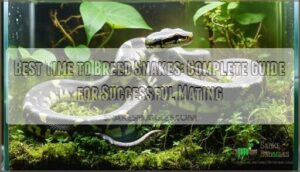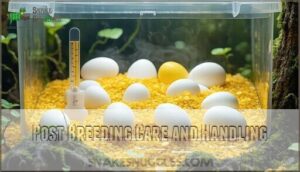This site is supported by our readers. We may earn a commission, at no cost to you, if you purchase through links.
 The best time to breed snakes depends on their species and natural habitat.
The best time to breed snakes depends on their species and natural habitat.
For temperate species like ball pythons, you’ll want to start breeding during cooler months – typically late fall through early spring when temperatures naturally drop.
This mimics their wild breeding cycles.
Tropical species often breed year-round but may respond better to slight temperature variations.
You’ll need to create the right environmental conditions with proper temperature drops, humidity levels, and photoperiod changes.
Most breeders begin pairing in November and aim for consistent monthly breeding until ovulation occurs.
Temperature control is everything – sudden changes can stress your snakes and ruin breeding success, emphasizing the importance of proper temperature drops and maintaining the right humidity levels to ensure successful breeding, which relies on careful temperature control.
Table Of Contents
- Key Takeaways
- Snake Breeding Season
- Best Time to Breed
- Snake Mating Process
- Breeding Ball Pythons
- Snake Egg Characteristics
- Breeding Challenges and Tips
- Post Breeding Care and Handling
- Frequently Asked Questions (FAQs)
- What month is breeding season for snakes?
- How much is a 2 year old ball python worth?
- Are snakes hard to breed?
- What time of year do pythons mate?
- What age should snakes start breeding?
- How long between breeding attempts?
- Can different snake species breed together?
- What supplements help breeding success?
- How to tell if breeding was successful?
- Conclusion
Key Takeaways
- Time your breeding during cooler months – You’ll get the best results pairing temperate species like ball pythons from November through March when natural temperature drops trigger their reproductive cycles.
- Control temperature changes gradually – You need to drop nighttime temps by 5-10 degrees over 6-8 weeks, since sudden changes will stress your snakes and ruin breeding success.
- Watch for clear ovulation signs – You’ll know she’s ready when your female shows pre-ovulation swelling, becomes restless, and you can feel firm follicle lumps along her sides.
- Maintain proper environmental conditions – You must keep humidity at 40-60% and use stable day temperatures of 80-85°F with 70-75°F nights for successful reproduction.
Snake Breeding Season
Understanding when to breed snakes starts with knowing their natural patterns.
Most temperate species breed in early spring after hibernation while tropical snakes can breed year-round but often follow seasonal cues.
Temperate Species Breeding
For temperate snake species, spring emergence marks the start of breeding season. Most species mate between March and May after winter dormancy ends.
This timing guarantees favorable environmental factors support successful reproduction. Some snakes, however, such as those in tropical regions, can breed throughout the year.
Key aspects of temperate breeding:
- Spring temperatures trigger mating rituals and follicular development
- Gestation period aligns with summer food abundance for neonate survival
- Regional variations affect exact timing based on local climate patterns
- Environmental factors like photoperiod and precipitation influence breeding success
- Annual cycles maximize offspring survival rates through seasonal synchronization
Tropical Species Breeding
Tropical snake species enjoy year-round breeding opportunities thanks to environmental consistency.
Unlike their temperate cousins, these snakes don’t rely on seasonal changes.
The rainy season often triggers increased mating activity as food abundance peaks.
You’ll find ideal conditions include stable temperatures and higher humidity levels.
Altitudinal impact plays a role too – lowland species breed more frequently than mountain dwellers throughout the breeding season.
Environmental Triggers
Your snake’s breeding success depends on reading nature’s signals correctly.
Temperature cues trigger hormonal changes that prepare snakes for mating behavior.
Rainfall patterns influence breeding timing since wet seasons often mean more food abundance for offspring survival.
Daylight duration affects reproductive cycles through photoperiod responses.
Humidity effects support proper egg development and reduce complications during snake reproduction.
These environmental factors work together during snake breeding season to optimize reptile breeding outcomes and ensure offspring survival.
Best Time to Breed
Timing your snake breeding efforts correctly can make the difference between success and frustration. You’ll want to follow nature’s blueprint for ideal timing. Most temperate species respond to seasonal variation cues from late winter to early spring.
This typically means starting your captive breeding program between November and March. Environmental cues play a huge role in triggering mating behavior. You’ll need to mimic natural conditions by adjusting temperature and light cycles.
Drop nighttime temperatures by 5-10 degrees and reduce daylight hours to simulate winter conditions. This cooling period should last 6-8 weeks. For breeding frequency, most snakes reproduce annually.
Some larger species like reticulated pythons may breed every other year. Ball pythons are your best bet for consistent breeding snakes success. They respond well to controlled environments and show clear signs when ready to mate.
Watch for females becoming restless and males showing increased activity. These behavioral changes signal the snake breeding season has begun. Success comes from patience and understanding snake reproduction cycles rather than rushing the process.
For ball pythons, understanding the breeding season timing is vital for success.
Snake Mating Process
Once you’ve established the right breeding conditions, understanding the actual mating process helps you recognize when breeding is successful.
The snake mating process involves three key stages that determine whether you’ll have healthy offspring, which is crucial for the breeding process to be considered successful.
Pairing and Ovulation
Getting your snakes together at the right moment makes all the difference.
Watch for these signs that show your female is ready for breeding and reproduction:
- Pre-ovulation swelling – Her body thickens noticeably in the middle section
- Behavioral changes – She becomes more active and restless than usual
- Follicle development – You can feel firm lumps along her sides
Pairing success depends on recognizing these ovulation signs.
Female readiness determines ideal timing for fertile eggs during the reproductive cycle.
Egg Deposition and Incubation
After mating success, your female snake enters a pivotal phase.
Egg deposition typically occurs 25-55 days post-ovulation, depending on species and environmental conditions.
She’ll seek humid, secluded spots for laying her clutch.
Proper incubation mediums like vermiculite guarantee egg viability during the 40-70 day gestation period.
Many breeders find incubation supplies are essential for successful hatching.
Humidity control prevents desiccation while temperature gradients support healthy development until hatchling emergence.
Proper humidity control and temperature gradients are crucial for the development of the eggs, ensuring they remain viable throughout the incubation period.
Optimal Temperature and Humidity
Creating the right environment feels like conducting an orchestra – every element must work together perfectly. Your snake breeding temperature should maintain 80-85°F during the day with 70-75°F nights. Reptile breeding humidity needs 40-60% levels for success.
A reliable thermostat is essential for maintaining these conditions.
Here are five critical monitoring steps:
- Install digital thermometers at multiple cage locations
- Use hygrometers to track humidity cycling patterns
- Create temperature gradients across the enclosure
- Adjust incubation ranges based on species variations
- Check monitoring equipment daily for accuracy.
Different species demand specific ideal conditions, so research your snake’s exact requirements before breeding begins. It is crucial to understand the species variations and apply the correct incubation ranges for successful breeding. Maintaining the right environment is key to reptile breeding success.
Breeding Ball Pythons
Ball pythons breed most successfully when you pair them during their natural breeding season from late November through March.
You’ll need to create controlled temperature drops and maintain specific ambient temperatures to trigger their reproductive instincts effectively.
Breeding Season for Ball Pythons
Ball pythons follow a specific breeding calendar that differs from many snake species.
Ball pythons march to their own reproductive rhythm, making timing absolutely crucial for breeding success.
You’ll want to start Python Pairing between late November and March when cooler months trigger their natural reproductive cycle.
This breeding window aligns with West Africa’s dry season when wild populations mate, and it’s crucial for Hatchling Success and Egg Incubation results, focusing your snake breeding tips around this timeframe for ideal outcomes, particularly for ideal Hatchling.
Controlled Temperature Drops
You’ll trigger ball python breeding by mimicking winter conditions through controlled temperature drops.
Lower nighttime temps to 70-75°F for 8-12 weeks while maintaining daytime warmth. This cool-down duration varies by species variation, but gradual changes work best.
Sudden drops can hurt fertility impact. Simulating winter naturally kickstarts their breeding cycle when you return to ideal conditions, which is why controlled temperature drops are crucial.
Ambient Temperature Ranges
Once you’ve set up cooling cycles, maintaining proper ambient temperatures becomes your next priority.
Reptile breeding temperature control requires precision to maximize success rates.
Your heating methods and thermostat settings should maintain these ideal conditions:
- Day temperatures: 80-85°F using ceramic heat emitters or radiant heat panels
- Night temperatures: 70-75°F with controlled cooling techniques and temperature monitoring
- Humidity levels: 40-60% to support snake breeding humidity requirements throughout the breeding cycle.
To guarantee accuracy, calibrate thermometers monthly.
Snake Egg Characteristics
Understanding snake eggs helps you know what to expect after successful breeding. You’ll recognize the signs of egg-laying and can prepare proper incubation setups when your snakes reproduce.
What Do Snake Eggs Look Like
Snake eggs have distinct characteristics that help you identify them during reptile breeding. Fresh eggs appear white or cream-colored with leathery shells that feel flexible unlike bird eggs.
The eggshell texture changes during incubation becoming more rigid. Candling eggs with a flashlight reveals developing embryos in fertile eggs. Infertile eggs remain clear throughout incubation.
| Feature | Fresh Eggs | During Incubation | Bad Eggs |
|---|---|---|---|
| Color | White/cream | Slightly yellowed | Moldy/discolored |
| Texture | Soft leather | Firmer leather | Collapsed/hard |
| Shape | Oval/elongated | Maintains shape | Dented/shrunken |
| Size | Species-specific | Slight expansion | May shrink |
Proper reptile care during this phase guarantees healthy snake husbandry outcomes.
How Many Eggs Do Snakes Lay
Depending on species, your snake can lay anywhere from 1 to 100 eggs per clutch size.
Ball pythons typically produce 4-10 eggs, while reticulated pythons may lay 25-80.
Corn snakes usually deliver 10-30 eggs.
Species differences dramatically affect reproductive frequency and egg variation.
Female size, health, and environmental factors affecting nutrition influence clutch output in reptile reproduction.
Where Do Snakes Lay Their Eggs
Female snakes choose nesting sites carefully for ideal clutch placement strategies and environmental egg protection.
Your breeding setup should mirror natural snake habitats with proper egg-laying substrates.
- Humid hide boxes – Use sphagnum moss or vermiculite substrates maintaining 80-90% humidity for successful reptile reproduction
- Underground burrows – Provide deep substrate allowing natural digging behaviors in your reptile breeding guide setup
- Rotting logs – Offer decomposing wood pieces that retain moisture and provide security during egg deposition
- Leaf litter piles – Create natural debris layers mimicking wild nesting site selection preferences perfectly
- Rock crevices – Supply tight spaces between stones for species preferring secure, temperature-stable locations
Breeding Challenges and Tips
Breeding snakes successfully requires careful attention to environmental conditions and timing.
You’ll face challenges like temperature fluctuations, poor fertility rates, and egg development issues if you don’t maintain proper humidity and avoid sudden climate changes, which are critical for successful breeding and can be influenced by proper humidity.
Common Breeding Challenges
When you venture into breeding snakes, you’ll face hurdles—like infertility issues, hatchling mortality, genetic defects, dystocia risks, and hybridization problems.
Each challenge needs attention for success.
Here’s a quick look:
| Challenge | Impact |
|---|---|
| Infertility Issues | Fewer viable eggs |
| Hatchling Mortality | Lower survival rates |
| Genetic Defects | Weaker offspring |
| Dystocia Risks | Health threats to moms |
Use this reptile breeding guide to spot trouble early and improve outcomes.
Tips for Successful Breeding
You’ll boost breeding snakes success by focusing on genetic diversity and female health.
Choose unrelated breeding pairs to prevent inbreeding issues.
Monitor your female’s weight and body condition before pairing.
Healthy males with good fertility rates produce better results.
Use proper incubation methods with stable temperatures.
Consider using a snake egg incubator to maintain ideal conditions.
Plan your hatchling care setup early.
These reptile breeding tips create perfect conditions for successful reproduction and help with hatchling care, ensuring healthy males and overall breeding success.
Avoiding Sudden Temperature Changes
Temperature shocks can devastate your breeding program’s fertility impact and hatching rates.
Gradual adjustments over several days create proper seasonal simulation while preventing thermoregulation stress that kills embryos.
Follow these reptile breeding tips for stable conditions:
- Drop temperatures 2-3°F daily during cooling periods
- Maintain consistent day/night cycles throughout breeding season
- Monitor humidity levels to prevent additional environmental stress
- Use quality thermostats with backup monitoring systems
This snake breeding information protects your investment. Sudden changes confuse their natural rhythms and reduce reproductive success dramatically, causing thermoregulation stress that can be mitigated with proper thermostats.
Post Breeding Care and Handling
Once you’ve successfully bred your snakes, the real work begins with proper post-breeding care.
You’ll need to handle delicate eggs and newborn hatchlings with precision while preventing any unwanted snake populations from developing.
Caring for Newborn Snakes
Your newborn snakes need proper enclosure setup with secure lids and clean substrate.
Maintain temperatures between 78°F to 84°F for ideal conditions.
First feeding occurs after their initial shedding process, typically 5-10 days post-hatch.
Watch for common ailments like respiratory infections or mites.
Use gentle handling techniques during brief interactions to build trust without causing stress.
They’re born independent, requiring no parental care, and need proper care to thrive, with secure lids to prevent escape.
Handling Snake Eggs and Hatchlings
Handle eggs and hatchlings with extreme care during your breeding snakes guide journey.
Move eggs gently during egg relocation to prevent membrane damage. Consider using a reptile egg incubator to maintain ideal conditions.
Here’s your reptile breeding care checklist:
- Initial handling – Wait 24-48 hours before touching newborns
- Enclosure setup – Prepare individual containers with proper ventilation
- Hatchling feeding – Offer first meals after initial shedding process
- Monitor closely – Watch for signs of stress or health issues
This reptile breeding information guarantees your best time to breed snakes efforts succeed.
Preventing Snake Infestations
Beyond proper breeding techniques, you’ll need to prevent wild snakes from establishing territories near your breeding area.
Remove food sources like rodents and secure potential hiding spots.
Here’s your snake-proofing plan:
| Prevention Method | Action Required | Effectiveness |
|---|---|---|
| Seal Entry Points | Close gaps under buildings | High |
| Remove Food Sources | Control rodent populations | High |
| Natural Repellents | Apply cinnamon or clove oil | Moderate |
| Professional Snake Removal | Call experts for active infestations | Very High |
| Snake-Proofing Yard | Install mesh fencing | High |
This breeding snakes guide guarantees your reptile breeding information stays focused on your captive animals, not unwanted visitors, and provides a comprehensive approach to snake management, ensuring a safe and effective breeding environment with proper techniques.
Frequently Asked Questions (FAQs)
What month is breeding season for snakes?
Most snakes breed during spring months, particularly March through May, when they’re emerging from winter hibernation.
You’ll find gravid females from May to July, with eggs laid during summer when food sources are abundant.
How much is a 2 year old ball python worth?
A two-year-old ball python’s value fluctuates wildly based on morph, genetics, and breeder reputation. You’ll typically pay $50-$300 for normals, while rare morphs can command thousands of dollars.
Are snakes hard to breed?
Breeding snakes isn’t particularly difficult, but you’ll need patience and attention to detail. Success depends on providing proper temperatures, humidity, and timing breeding cycles correctly.
What time of year do pythons mate?
Python breeding absolutely explodes during late fall through early spring! You’ll typically pair pythons from November to March when cooler temperatures trigger their natural breeding instincts perfectly.
What age should snakes start breeding?
You’ll want to wait until your female reaches sexual maturity rather than focusing on age alone.
Most species need females to hit minimum weight thresholds – typically 1,500-2,000 grams for ball pythons or similar sizes for other species before they’re ready.
How long between breeding attempts?
Like a careful gardener spacing plantings, you’ll want to give your female snake proper recovery time between breeding cycles.
Wait at least one full year between attempts to guarantee she regains body condition and health.
Can different snake species breed together?
No, different snake species can’t breed together successfully. You’ll find that interspecies breeding either fails completely or produces sterile offspring. Stick with same-species pairings for healthy, viable babies.
What supplements help breeding success?
Like a nutritional foundation for a towering tree, supplements fuel your snake’s reproductive success.
You’ll need calcium for strong eggs, vitamin D3 for absorption, and multivitamins for overall health during breeding season.
How to tell if breeding was successful?
You’ll notice female snakes becoming gravid (swollen with eggs) about 4-6 weeks after successful mating. Look for increased appetite initially, then appetite loss before egg-laying or birth.
Conclusion
Mastering the best time to breed snakes is absolutely game-changing for any serious breeder.
You’ll achieve success by timing your breeding cycles with natural seasonal patterns. Start pairing temperate species during cooler months from November through March.
Monitor temperature drops carefully and maintain proper humidity levels throughout the process. Remember that consistency beats perfection every time.
Your snakes will reward your patience with healthy clutches when you follow these proven guidelines.
- https://aaacwildliferemoval.com/blog/snakes/breeding-season-of-a-snake/
- https://www.herpconbio.org/Volume_5/Issue_1/Meshaka_2010.pdf
- https://www.reddit.com/r/ballpython/comments/s9nfit/what_is_the_best_time_of_year_to_get_a_new_bp/
- https://pmc.ncbi.nlm.nih.gov/articles/PMC7109017/
- https://reptilesupershow.com/mastering-snake-breeding-tips-for-healthy-serpents/
















